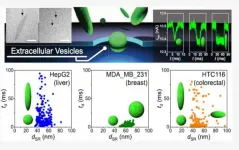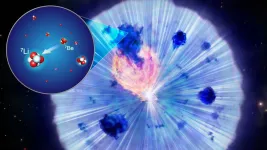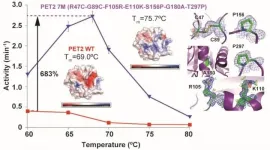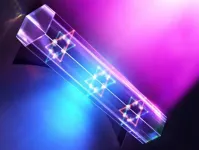The shape of nanoparticles in body fluids may help identify the type of cancer
2021-07-07
(Press-News.org) A recent study by scientists from Japanese universities has shown that the shape of cell-derived nanoparticles, known as "extracellular vesicles" (EVs), in body fluids could be a biomarker for identifying types of cancer. In the study, the scientists successfully measured the shape distributions of EVs derived from liver, breast, and colorectal cancer cells, showing that the shape distributions differ from one another. The findings were recently published in the journal Analytical Chemistry.
Early detection of cancerous tumors in the body is essential for effective treatments. However, it is difficult to detect all types of tumors at an early stage, because detection methods differ among types of cancer, and some of the methods require painful medical procedures. It is thus vital to find methods that are painless and can detect multiple types of cancer.
Extracellular vesicles (EVs) are biological particles with a diameter of about 100 nanometers (nm) that are secreted from various cells and exist in body fluids like blood and urine. Notably, EVs contain biological molecules that carry information about the cells of the secretion sources. In addition, genetic materials contained in EVs are involved in communications among cells. This suggests that analyzing biological molecules in EVs present in body fluids could help to detect and identify some kinds of cancerous tumors in the body.
Previous studies had observed images of various shapes of EVs with electron microscopes. However, no technology existed to investigate the shapes of EVs distributed in body fluids, mainly because of difficulties in measuring the shape of nanomaterials in solution. In this context, a team of researchers from Kyushu University, Nagoya University, Osaka University, and Tokyo Medical University tried to investigate the shape of individual EVs in a fluid using a device that they had developed, which can analyze the shape of single particles in solution by measuring the change of ionic current flowing through pores of 200 nm in diameter when particles pass through there.
Using the device, the team successfully measured the shape of EVs derived from cultured liver, breast, and colon cancer cells, as well as from cultured normal breast cells, and found that their shape distributions differ from each other. For example, EVs derived from liver cancer cells include a mix of spherical particles and oval (like rugby balls) particles, whereas EVs from breast cancer cells consist solely of spherical particles.
The team then compared shape distributions of EVs in blood samples from breast cancer patients and non-cancerous individuals. The results showed that the shape distributions of EVs from the two groups differ from each other, indicating that measuring shape distributions of EVs in blood could distinguish patients with breast cancer from non-cancerous individuals.
"In this study, we found that measuring shape distributions of EVs in body fluids could identify the type of cancer," said Associate Professor Takao Yasui at the Nagoya University Graduate School of Engineering, one of the authors of the study.
The researchers note that measuring a greater variety of types of EVs will provide them with a more accurate idea of potential EV shape distributions as an index for cancer detection, screening, and diagnosis.
INFORMATION:
The paper, "Rapid Discrimination of Extracellular Vesicles by Shape Distribution Analysis," was published online in the journal Analytical Chemistry on April 28, 2021, at https://pubs.acs.org/doi/10.1021/acs.analchem.1c00258
About Nagoya University, Japan
Nagoya University has a history of about 150 years, with its roots in a temporary medical school and hospital established in 1871, and was formally instituted as the last Imperial University of Japan in 1939. Although modest in size compared to the largest universities in Japan, Nagoya University has been pursuing excellence since its founding. Six of the 18 Japanese Nobel Prize-winners since 2000 did all or part of their Nobel Prize-winning work at Nagoya University: four in Physics - Toshihide Maskawa and Makoto Kobayashi in 2008, and Isamu Akasaki and Hiroshi Amano in 2014; and two in Chemistry - Ryoji Noyori in 2001 and Osamu Shimomura in 2008. In mathematics, Shigefumi Mori did his Fields Medal-winning work at the University. A number of other important discoveries have also been made at the University, including the Okazaki DNA Fragments by Reiji and Tsuneko Okazaki in the 1960s; and depletion forces by Sho Asakura and Fumio Oosawa in 1954.
Website: http://en.nagoya-u.ac.jp/
[Attachments] See images for this press release:

ELSE PRESS RELEASES FROM THIS DATE:
2021-07-07
New York, NY (July 6, 2021) - Mount Sinai researchers have uncovered the complex cellular mechanisms of Ebola virus, which could help explain its severe toll on humans and identify potential pathways to treatment and prevention. In a study published in mBio, the team reported how a protein of the Ebola virus, VP24, interacts with the double-layered membrane of the cell nucleus (known as the nuclear envelope), leading to significant damage to cells along with virus replication and the propagation of disease.
"The Ebola virus is extremely skilled at dodging the body's immune defenses, and in our study we characterize an important way in which that evasion occurs through disruption of the nuclear envelope, mediated by the VP24 protein," says co-senior ...
2021-07-07
QUT PhD researcher Zachariah Schuurs said the research team had identified a new binding site on the SARS-CoV-2 spike protein.
"Binding of the CoV-2 spike protein to heparan sulphate (HS) on cell surfaces is generally the first step in a cascade of interactions the virus needs to initiate an infection and enter the cell.
"Most research has focused on understanding how HS interacts on the receptor-binding domain (RBD) and furin cleavage site of the SARS-CoV-2 virus's spike protein, as these typically bind different types of drugs, vaccines and antibodies.
"We have identified a novel binding site on the N-terminal domain (NTD), a different area of the virus's spike that facilitates the binding of HS. This helps to better understand how the virus ...
2021-07-07
A new study of lithium production in a classical nova found a production rate of only a couple of percent that seen in other examples. This shows that there is a large diversity within classical novae and implies that nova explosions alone cannot explain the amount of lithium seen in the current Universe. This is an important result for understanding both the explosion mechanism of classical novae and the overall chemical evolution of the Universe.
In the modern world, lithium is used in the rechargeable batteries powering smartphones and other devices. ...
2021-07-07
Cheap to produce and long to degrade, plastic was once a manufacturing miracle. Now, plastic is an environmental plague, clogging landfills and choking waterways. A Japan-based research team has turned back to nature to develop an approach to degrading the stubborn substance. Similar to how a protein binds to cellulose in plants or to chitin in crustaceans to initiate decomposition, an engineered protein is on its way to binding to plastic particles in an effort to more efficiently break them down.
They published their results on June 29 in ACS Catalysis, a journal of the American Chemical Society.
"Polyethylene ...
2021-07-07
In two recent articles published in Schizophrenia Bulletin, Sharon Hunter, PhD, an associate professor in the University of Colorado School of Medicine Department of Psychiatry, and M. Camille Hoffman, MD, MSc, an associate professor in the University of Colorado School of Medicine Department of Obstetrics and Gynecology, along with their research group, have uncovered a potential link between choline deficiency in Black pregnant women in the United States and increased risk of developmental and behavioral issues that can evolve into mental illness later in their children's lives.
The first article, published in November 2020, is a study, titled, "Black American Maternal Prenatal Choline, Offspring Gestational Age at Birth, and Developmental Predisposition to Mental Illness." The ...
2021-07-07
Scientists at KAIST have fabricated a laser system that generates highly interactive quantum particles at room temperature. Their findings, published in the journal Nature Photonics, could lead to a single microcavity laser system that requires lower threshold energy as its energy loss increases.
The system, developed by KAIST physicist Yong-Hoon Cho and colleagues, involves shining light through a single hexagonal-shaped microcavity treated with a loss-modulated silicon nitride substrate. The system design leads to the generation of a polariton laser at room temperature, which is exciting because this usually requires cryogenic temperatures.
The researchers found another unique and counter-intuitive feature of this design. Normally, energy is lost during laser operation. ...
2021-07-07
Australian scientists researching how our immune system responds to COVID-19 have revealed that those infected by early variants in 2020 produced sustained antibodies, however, these antibodies are not as effective against contemporary variants of the virus.
The research is one of the world's most comprehensive studies of the immune response against COVID-19 infection. It suggests vaccination is more effective than the body's natural immune response following infection and shows the need to invest in new vaccine designs to keep pace with emerging COVID variants.
Published today in PLOS ...
2021-07-07
Polymer composite materials that combine magnetic and electrical properties are the subjects of particular attention for modern-day researchers. Their basic property is the ability to convert electric polarization into a magnetic field and vice versa. Although some materials exhibit a much better magnetoelectric effect, polymer-based composites are easier not only to produce but also to modify.
Such composites have great potential in a variety of different fields. For example, using them as a basis, scientists can develop surfaces that help cultivate various cells. In this case, polymer composites serve as a substrate through which it is possible to affect the culture using a non-contact and controlled electric charge and morphological properties ...
2021-07-07
DANVILLE, Pa. - Having multiple chronic health conditions and living in a rural area were the top two factors affecting increased healthcare system contact among older patients with bladder cancer, a research team has found.
The Geisinger-led team evaluated 73,395 Medicare beneficiaries age 66 and older who had been diagnosed with non-muscle-invasive bladder cancer to assess their treatment burden, defined as the number of days the patients had contact with a health system in the year following diagnosis.
Nearly two-thirds of the patients had multiple co-existing chronic conditions at the time of bladder cancer diagnosis, as well as other aging-related conditions, including a history of falls, ...
2021-07-07
Opioid prescribing preferences and practices among surgical residents and faculty differ, according to a new study published in the journal Surgery.
The study, titled "Evaluation of opioid prescribing preferences among surgical residents and faculty," was based on a survey of 56 residents and 57 faculty within the University of Colorado School of Medicine Department of Surgery. In the survey, participants were asked how many oxycodone tablets they would prescribe for 14 common surgical procedures.
Answers were compared between residents and faculty, as well as against the Opioid Prescribing Engagement Network (OPEN) guidelines and actual opioids ...
LAST 30 PRESS RELEASES:
[Press-News.org] The shape of nanoparticles in body fluids may help identify the type of cancer




